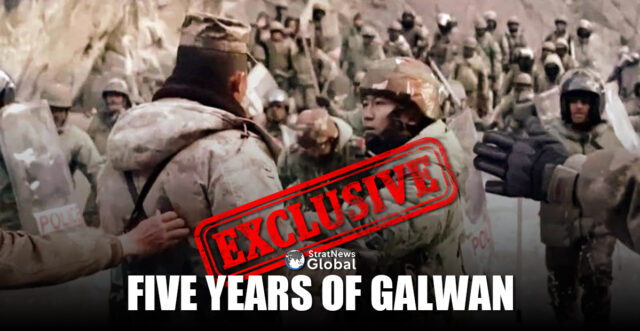On Sunday, it would be five years since the fateful clash at Galwan between Indian and Chinese troops shook up years of peace and tranquility on the Line of Actual Control (LAC) between the two countries.
Much water has flowed down the Shyok river on the banks of which the clash took place. India accepted 20 soldiers were killed in the skirmish in which the Chinese used clubs and barbed wire-laced sticks to attack Indian troops, who retaliated after being surprised initially. Lt Gen YK Joshi (retd), who was heading the Indian Army’s Northern Command at the time, estimated that up to 40 People’s Liberation Army (PLA) troops were killed, although the Chinese traditionally never admit their casualties or are known to release fatality figures years later.
Galwan, A Game Changer
In retrospect, Galwan has turned out to be an inflexion point not just for the relationship between the two countries but also for India’s defence and strategic policies. The faceoff that began in the summer of 2020 between the Indian and Chinese ground forces almost all along the 800 km stretch in Eastern Ladakh has led to a much-needed rebalancing of the Indian military and a focused attention to improve and strengthen border infrastructure in the past five years. The urgency of a resolute response to the Chinese aggression accelerated the pace of reorientation of the Indian security posture, achieving a desirable dissuasive state in less than half the time it would otherwise have taken in normal course.
Force Rebalancing
Creating a new ORBAT (Order of Battle) and raising new formations has resulted in a more robust presence all along the northern borders. According to top military sources, the rearrangement of formations was carried out in two phases. Between June 2020 and December 2022, ‘Rebalancing 1.0’ was undertaken in which certain reserve formations were inducted and deployed in Ladakh.
Northern Command Reserve, the Palampur-based 39 Division for instance, was deployed south of Pangong Tso in the initial stages of the standoff. Elements of the 17 Mountain Strike Corps were also part of the initial surge of troops witnessed in Ladakh. Several (up to a dozen) armoured and mechanised regiments were inducted into the sector. Many more artillery guns than ever before were deployed.
In August 2020, India surprised the Chinese by executing a QPQ or quid pro quo action on the Kailash range of mountains, climbing the hitherto unoccupied Richen la-Rezang la hill complex and the high peaks on the northern bank of the Pangong Tso. This counter move forced the Chinese to become more accommodative in the negotiations that followed, resulting in the first phase of disengagement in February 2021.
As negotiations were progressing, the military was augmenting troop strength, improving the infrastructure (including defences, roads, bridges, tunnels and permanent habitats for the troops) and strengthening the security grid. The Mathura-headquartered Strike One, one of the three Strike Corps designated for the Western Front, was allocated to Northern Command as an offensive formation. The Leh-based 14 Corps, raised in the wake of the Kargil conflict in 1999, was already holding the line along the Eastern Ladakh front. It was beefed up with additional resources. A Division size Counter-Insurgency Force (CIF) Uniform, located at Reasi in the Jammu Division was deployed South of Pangong Tso while the 3 Division, one of the two original formations under 14 Corps (the other being 8 Mountain Div, looking after the Kargil-Drass-Batalik sector along the Line of Control with Pakistan) now guards the LAC from Karakoram pass to north bank of the Pangong Tso.
By December 2022, ‘Rebalancing 1.0’ was complete.
‘Rebalancing 1.5’
From January 2023, ‘Rebalancing 1.5’ was rolled out to consolidate the initial surge and deployment. Strike One, now redesignated as Mountain Strike Corps (West), was allocated the Bareilly-based 6 Division (earlier and Army HQ reserve) in addition to 4 Division and an armoured brigade. These formations continue to exercise in Ladakh to be ready for any eventuality. Meanwhile, the 39 Division has gone back to Palampur but continues to be acclimatised and ready to be deployed in high-altitude areas at short notice.
In the Eastern Command, 17 Corps, headquartered at Panagarh in West Bengal, raised as India’s first Mountain Strike Corps, is the designated offensive formation, besides three other formations—3,4 and 33 Corps—looking after the entire Tibet (China) border from Sikkim to Arunachal Pradesh.
Simultaneously, ‘Rebalancing 1.5’ was extended to the Western Front too by shuffling formations, recalibrating capability development plans and simultaneously developing multi-domain operations capability along the western front has been carried out over the past 25 months. The ongoing rebalancing includes review of dual-task formations (under which certain forces are trained to operate along different fronts as necessary), creation of new tailor-made formations in the fields of ISR (intelligence, surveillance and reconnaissance), Special Operations, combined or integrated all arms brigades and information operations groups.
Operation Sindoor may have reignited interest on the Western Front but the Indian military still has a razor-sharp focus on the northern border with Tibet. China and India are currently engaged in finding ways to consolidate the hard-earned peace on the disputed border between the two, but in the minds of India’s military planners, China is now firmly embedded as the primary challenge. That’s an undisputed fact exactly five years since the Galwan clash.
Nitin A. Gokhale is a media entrepreneur, one of South Asia's leading strategic affairs analyst and author of over a dozen books so far on military history, insurgencies and wars.
Starting his career in journalism in 1983, he has since led teams of journalists across media platforms.
A specialist in conflict coverage, Gokhale has covered the insurgencies in India’s North-East, the 1999 Kargil conflict and Sri Lanka’s Eelam War IV between 2006-2009.
Gokhale now travels across the globe to speak at seminars and conferences, and lecture at India’s premier defence colleges. He has founded three niche portals, Bharatshakti.in, stratnewsglobal.com and Interstellar.news.





